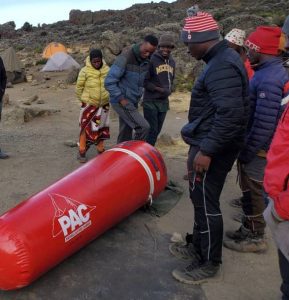Recently we have seen an increase in potential climbers asking asking to include a night at Crater Camp into their trek. Initially it appeared that this was just part of the trend of people wanting to do something that is off the beaten path, more extreme, and something unique.
But then we received a call from James, a 52 year old, asking us about hiking the Western Breach and sleeping at the Crater Camp. Shockingly, James had never hiked more then an hour, had never been above 1,200 feet in altitude, and had never slept a night in a tent. Another company had sold him on the idea of the Ultimate Adventure on Kilimanjaro, hiking the Western Breach and sleeping at crater camp, telling him that no experience was needed and even out of shape people do this trek regularly.
This is when we realized that Crater Camp, as well as the Western Breach, are now being used as a marketing tool for companies to build their niche. With little or no regard for the safety of their clients and crew, they are selling a pipe dream, which in the end is extremely dangerous. Thus, we felt the need to write this blog post to explain in detail why the Crater Camp is not a safe option for nearly everyone.
Why the “Ultimate Adventure” Isn’t a Wise Choice
For some climbers, spending a night at Crater Camp—perched near Kilimanjaro’s summit at roughly 5,730 meters (18,800 feet)—is the ultimate badge of adventure. The idea of sleeping on the roof of Africa, surrounded by ancient glaciers and under a sky bursting with stars, is undeniably appealing.
But what many trekkers don’t realize is that Crater Camp is one of the most extreme and risky overnight locations in all of Africa. It’s not just dirty, cold, and uncomfortable—it is genuinely dangerous, even for fit, experienced hikers, as well as for the mountain crew.
What Makes Crater Camp So Extreme
Crater Camp sits just below Uhuru Peak, the highest point on Kilimanjaro. At that altitude, oxygen levels are less than 50% of what they are at sea level. This means every breath contains only half as much oxygen as your body is used to—forcing your heart, lungs, and brain to work much harder.
Most climbers summit Kilimanjaro and descend immediately to a safer altitude for rest. Sleeping at Crater Camp means prolonged exposure to extreme altitude, which dramatically increases the risks of altitude-related illnesses.
The Main Dangers of Sleeping at Crater Camp
1. Severe Altitude Sickness
Even well-acclimatized climbers can develop Acute Mountain Sickness (AMS), or worse, High Altitude Pulmonary Edema (HAPE) or High Altitude Cerebral Edema (HACE). The relatively few number of days that are spent hiking up Kilimanaro, won’t allow you to acclimate to a level needed to sleep at Crater Camp. These conditions can escalate quickly and become life-threatening if not treated immediately.
Symptoms may include:
-
Intense headaches
-
Nausea and vomiting
-
Confusion or disorientation
-
Shortness of breath even at rest
-
Fluid in the lungs or swelling of the brain
At Crater Camp, there’s no easy escape. A descent starts with the challing hike out of the crater to the rime, before being able to descend. Descending to a safer altitude in the dark or bad weather can be dangerous and logistically difficult.
2. Freezing Night Temperatures
Nighttime temperatures often plunge below -15°C (5°F), with fierce winds and minimal shelter from the elements. Frostbite, hypothermia, and extreme discomfort are real risks—especially after the physical strain of the hike to get there.
3. Limited Recovery and Rest
After hiking to extereme altitudes, your body desperately needs oxygen-rich air to recover. Sleeping at high altitude instead of descending means your body continues to deteriorate overnight. This can lead to exhaustion, dehydration, and poor performance the next day.
4. Logistical and Safety Challenges
Crater Camp is a remote, exposed site. There are no rescue vehicles, no permanent facilities, and limited ability for guides to assist if a serious emergency arises. Helicopters can’t fly to this altitude. Even experienced expedition teams consider it a high-risk overnight stop.
Why Most Climbers Skip Crater Camp
While some high-end or “extreme” itineraries advertise a Crater Camp night as a luxury or rare experience, most responsible outfitters discourage it.
Instead, the vast majority of climbers summit early in the morning and then descend safely to a much lower camp to rest and recover.
This approach allows you to experience the breathtaking Crater Rim without jeopardizing your health or safety.
A Safer Alternative
If you’re drawn to the allure of Crater Camp—the glaciers, the vast lunar landscape, and the feeling of being on top of the world—you can still experience it responsibly:
-
Choose a longer acclimatization route (such as the Northern Circuit).
-
Visit the crater during the day after summiting. If the weather permits and the climber has no symptoms of altitude sickness, you may have the chance to discend into the crater and cross the crater en route back to Stella Point. The guide will evaluate each climber and must feel that you have the strength and energy that are required to hike back up to the rim and then continue your descent.
-
Please remember that this option is only possible for climbers on a private trek, as we must be able to ensure all climbers safety at all times.
You’ll still enjoy the wonder of the crater while minimizing the risk of altitude illness.
The Bottom Line
Sleeping at Crater Camp might sound like a once-in-a-lifetime experience—but it’s not a risk worth taking for most climbers. The high altitude, freezing temperatures, and limited options for evacuation make it Africa’s most dangerouse overnight options.
The safest and most rewarding way to experience Kilimanjaro’s summit is to reach the top, take it in, and descend safely. After all, the true goal isn’t just to stand on the summit—it’s to return safely to tell the story.
Thinking of tackling Kilimanjaro?
Our experienced guides design safe, sustainable, and meaningful treks that maximize your summit success while prioritizing your health and wellbeing.



